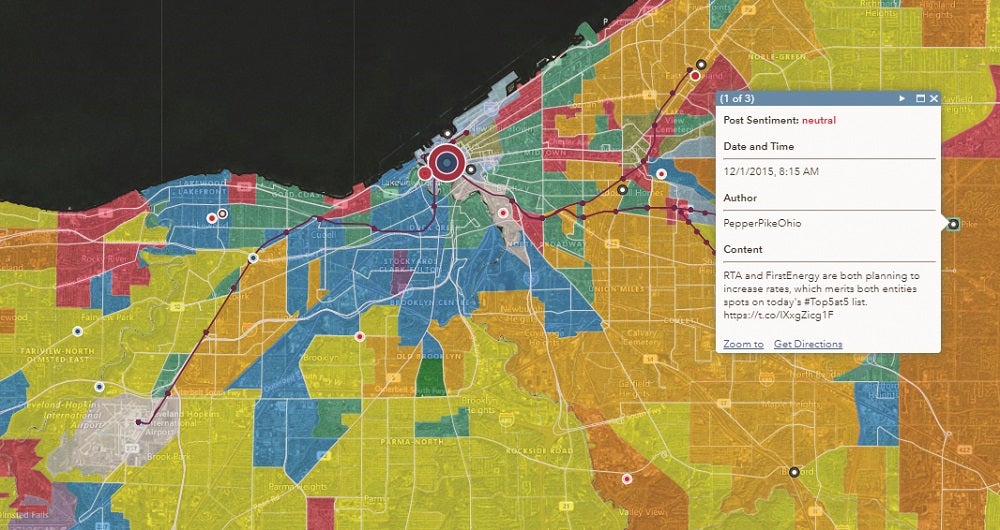
STRATA: Improving the Stakeholder Experience Through Data-Driven Engagement
Informing and Enhancing Our Approach to Public Understanding
STRATA is a service jointly executed by our geospatial and information management and strategic communications teams and that uses data to inform and enhance our approach to public understanding. Our STRATA team practices data-driven engagement beyond standard demographics, and tailors public involvement and decision-making approaches specifically for every project.
We believe all infrastructure projects have the same goal — to improve the human experience through innovation and technology. We also believe all project teams face the same challenge — effective communication with the communities they seek to improve. Engaging communities posed its challenges in the past, then COVID-19 happened. In a matter of months, the entire human experience transformed and limited many of us to the confines of our homes and the comfort of our screens. The values, priorities, need and uncertainties of every person and industry completely shifted.
The year 2020 brought long-standing physical and emotional fatigue, and tremendous financial insecurities to families across the globe. Through it all, people found new ways to communicate, innovate and collaborate — our team felt prepared for these shifts, as we have the tools to understand communities down to the neighborhood level, and consistently use this information to develop strategic communication strategies across
virtual landscapes.
There are few one-size-fits-all projects, the same way there is no one-size-fits-all approach to communication plans. We take a deep dive into identifying characteristics, perceptions and communication needs across all project areas. Our goal is to gauge and mitigate social and political risks before they affect a project. This is the basis of STRATA.
To be candid, STRATA exposes the truth of the human experience through comprehensive analysis from a technical and empathic lens. Through this, our clients are able to acknowledge the raw and complex emotions of 2020 that will continue to impact public perceptions, priorities, comfort and engagement for years to come. Whatever “the new normal” becomes, our team is prepared to educate key decision-makers to clearly display community perceptions and needs.
We leverage commercial off-the-shelf tools to develop powerful applications for communication strategies and issues mapping. These tools enable us to extract, analyze and present demographics, lifestyle patterns and behaviors, and market potential indices to better understand the overall community. We can quickly generate reports, interactive maps, dashboards and infographics to create powerful visual profiles and to assess potential social and political risks.
The STRATA team leverages large data sets to visually display social and political risk nationwide. Controversy is costly, both in reputation and in dollars. Social and political risk deserves attention at the planning stage of a project or program, where it can be carefully assessed and when there is time to develop strategies to mitigate or diminish risk.
Social Listening
Our STRATA team can provide 24/7 listening on social media platforms and use sentiment analysis to determine trends, specify key influencers and identify or mitigate risk. Social media listening allows us to track project success by measuring the effectiveness of messaging and communication. Through social media listening, we can answer the following questions throughout the life of any project:
- Who are we reaching?
- What are they saying?
- Where are they?
- What are we missing?
Social listening — along with other tools like geospatial data, demographic and socioeconomic data — offers an in-depth snapshot of project stakeholders, allowing for a comprehensive understanding and more tailored approach to strategic enhancement and site suitability studies.

A STRATA Success Story
The Harris County Flood Control District and the Federal Emergency Management Agency are partnering to deliver MAAPnext, a program that aims to empower local residents by providing better flood risk mapping and information to help build the community’s resilience to future floods. We prepared an Audience Sentiment Assessment for the District to identify prevalent public sentiments that could pose threats or distractions over the course of the MAAPnext effort. This thoughtful and intensive analysis of county demographic and socioeconomic profiles, social commentary, historical flooding data, FEMA property damage and local and national news media coverage unveiled underlying public perceptions county-wide and by precinct. It also examined the factors that likely influenced those perceptions. Ultimately, the findings helped inform the MAAPnext communications and outreach approach. Understanding the county’s demographic and socioeconomic characteristics provided the insight needed to reach residents with messages that resonate and are delivered in the places and formats they prefer throughout the life of the project.
Managing Social and Political Risks
In an era when advocacy groups both for and against your efforts can spring up and go global in an instant, understanding your audience is essential. Poorly informed viral campaigns can cause lasting damage to corporate or agency brands and ruin professional reputations in the blink of an eye. In an industry where perfectly planned initiatives might have solved important societal problems, they experience costly delays or are never realized at all because of social and political resistance.
Social and political risk is a real and important factor to consider when launching new policies, programs or projects. It deserves careful attention at the planning stage where it can be carefully assessed and when there is time to develop strategies to mitigate against or diminish the risk. Preparing a social and political risk assessment can creatively present data to identify community or regional sentiment and assess how it relates to project goals.
This crucial knowledge helps project teams develop approaches to communications and stakeholder involvement. Understanding our "new normal” of virtual engagement, and with even more conversations occurring online, taking the temperature of the area prior to bringing a project to the public will help manage potential risk and prepare a team for issues that may arise. Analyzing the social, political and regulatory climate, historical and cultural overview, key influencers and decision makers, and socioeconomics help our clients strategize and create informed decisions about how to move forward with projects.



